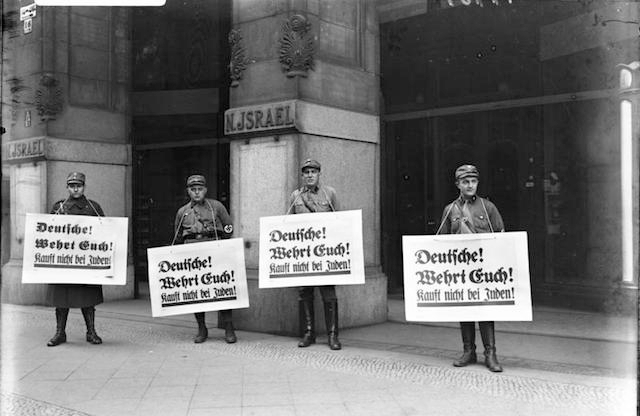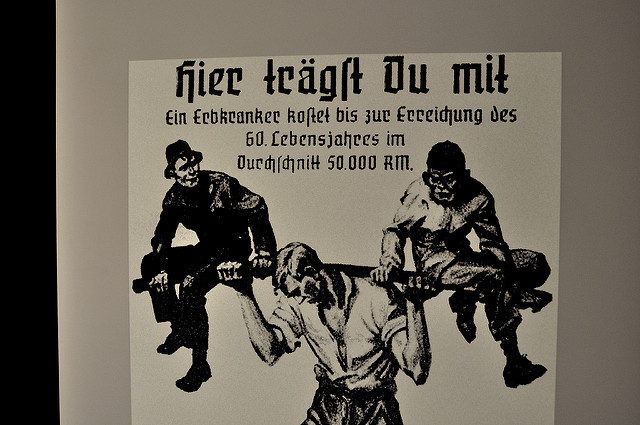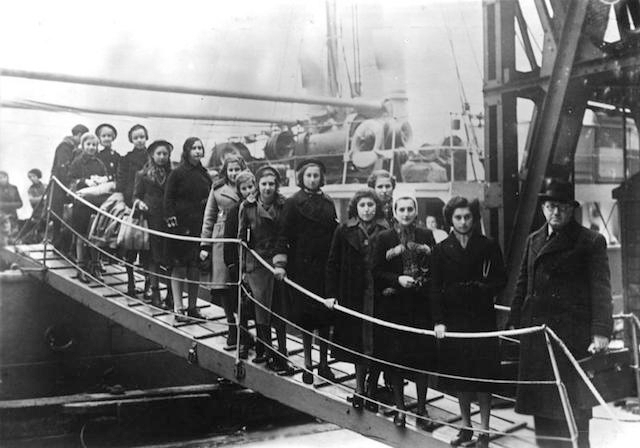In April 1933 What Were the Rights or Freedoms Taken Away From Juices and Suit Again
On Jan 30, 1933, Adolf Hitler was named chancellor, the most powerful position in the German government, by the aged President Hindenburg, who hoped Hitler could lead the nation out of its grave political and economic crunch. Hitler was the leader of the right-wing National Socialist German Workers Party (called "the Nazi Party" for short). It was, by 1933, one of the strongest parties in Germany, even though — reflecting the country'southward multiparty arrangement — the Nazis had won simply a plurality of 33 percentage of the votes in the 1932 elections to the German parliament (Reichstag).
To read contemporary news accounts of the Holocaust and other Jewish events from 1917 on, search the JTA Archive.
Dismantling Deutschland's Democracy

Once in power, Hitler moved quickly to terminate German language democracy. He convinced his cabinet to invoke emergency clauses of the constitution that permitted the pause of individual freedoms of press, voice communication, and associates. Special security forces — the Gestapo, the Storm Troopers (SA), and the SS — murdered or arrested leaders of opposition political parties (Communists, socialists, and liberals). The Enabling Human action of March 23, 1933 — forced through the Reichstag already purged of many political opponents –gave dictatorial powers to Hitler.
READ: Jewish Reactions to the Enabling Act (March 24, 1933)
Also in 1933, the Nazis began to put into practice their racial ideology. The Nazis believed that the Germans were "racially superior" and that there was a struggle for survival betwixt them and inferior races. They saw Jews, Roma (Gypsies), and the handicapped as a serious biological threat to the purity of the "German language (Aryan) Race," what they called the main race.
Jews, who numbered well-nigh 525,000 in Germany (less than one percentage of the total population in 1933) were the principal target of Nazi hatred. The Nazis identified Jews equally a race and defined this race every bit "inferior." They also spewed hate-mongering propaganda that unfairly blamed Jews for Germany's economic depression and the state'southward defeat in Globe State of war I (1914-1918).
Nuremberg Laws, Property Seizures and Kristallnacht
In 1933, new German laws forced Jews out of their civil service jobs, university and police court positions, and other areas of public life. In April 1933, laws proclaimed at Nuremberg fabricated Jews 2nd-class citizens. These Nuremberg Laws divers Jews, not by their religion or past how they wanted to place themselves, just by the religious affiliation of their grandparents. Between 1937 and 1939, new anti-Jewish regulations segregated Jews further and fabricated daily life very difficult for them. Jews could not attend public schools; go to theaters, cinema, or vacation resorts; or reside or fifty-fifty walk in certain sections of High german cities.
Too betwixt 1937 and 1939, Jews increasingly were forced from Deutschland's economic life. The Nazis either seized Jewish businesses and properties outright or forced Jews to sell them at deal prices. In November 1938, the Nazis organized a anarchism (pogrom), known every bit Kristallnacht (the "Night of Broken Glass"). This attack against German language and Austrian Jews included the physical destruction of synagogues and Jewish-owned stores, the abort of Jewish men, the vandalization of homes, and the murder of individuals.
Non-Jewish Targets of Persecution

Although Jews were the chief target of Nazi hatred, the Nazis persecuted other groups they viewed as racially or genetically "inferior." Nazi racial ideology was buttressed by scientists who advocated "selective breeding" (eugenics) to "improve" the human race. Laws passed betwixt 1933 and 1935 aimed to reduce the future number of genetic "inferiors" through involuntary sterilization programs: 320,000 to 350,000 individuals judged physically or mentally handicapped were subjected to surgical or radiations procedures and then they could non have children. Supporters of sterilization likewise argued that the handicapped burdened the customs with the costs of their care. Many of Germany'due south thirty,000 Roma (Gypsies) were also somewhen sterilized and prohibited, along with Blacks, from intermarrying with Germans. Well-nigh 500 children of mixed African-German backgrounds were as well sterilized. New laws combined traditional prejudices with the racism of the Nazis, which defined Roma by "race" and equally "criminal and asocial."
Some other consequence of Hitler's ruthless dictatorship in the 1930s was the arrest of political opponents and merchandise unionists and others whom the Nazis labeled "undesirables" and "enemies of the state." Some 5,000 to 15,000 homosexuals were imprisoned in concentration camps; under the 1935 Nazi-revised criminal code, the mere denunciation of a man as "homosexual" could result in arrest, trial, and conviction. Jehovah'south Witnesses, who numbered at to the lowest degree 25,000 in Germany, were banned as an arrangement equally early as April 1933, because the beliefs of this religious group prohibited them from swearing whatever adjuration to the state or serving in the German armed forces. Their literature was confiscated, and they lost their jobs, unemployment benefits, pensions, and all social welfare benefits. Many Witnesses were sent to prisons and concentration camps in Nazi Federal republic of germany, and their children were sent to juvenile detention homes and orphanages.
Refugees With No Place to Go

Between 1933 and 1936, k of people, mostly political prisoners, were imprisoned in concentrations camps, while several thousand High german Roma were confined in special municipal camps. The first systematic circular-up of German and Austrian Jews occurred afterward Kristallnacht, when approximately xxx,000 Jewish men were deported to Dachau and other concentration camps, and several hundred Jewish women were sent to local jails. The wave of arrests in 1938 besides included several thousand High german and Austrian Roma.
Betwixt 1933 and 1939, about half of the German language-Jewish population and more than than ii-thirds of Austrian Jews (1938-1939) fled Nazi persecution. They emigrated mainly to the U.s.a., Palestine, elsewhere in Europe (where many would be subsequently trapped by Nazi conquests during the war), Latin America, and Japanese-occupied Shanghai (which required no visas for entry). Jews who remained under Nazi dominion were either unwilling to uproot themselves or unable to obtain visas, sponsors in host countries, or funds for emigration. Most foreign countries, including the United States, Canada, Britain, and France, were unwilling to admit very large numbers of refugees.
Reprinted courtesy of the Usa Holocaust Memorial Museum.
Source: https://www.myjewishlearning.com/article/1933-1939-early-stages-of-persecution/
0 Response to "In April 1933 What Were the Rights or Freedoms Taken Away From Juices and Suit Again"
Post a Comment